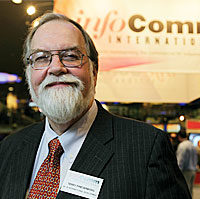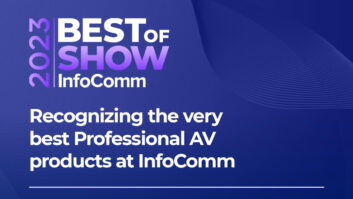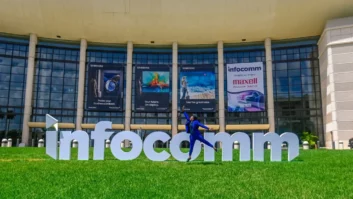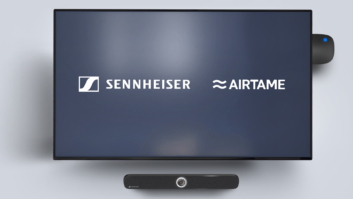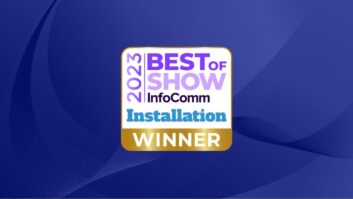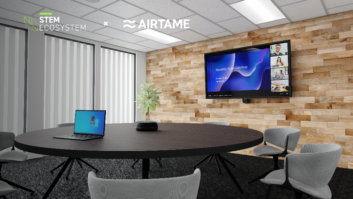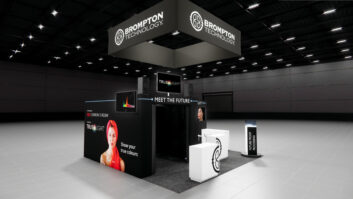Paddy Baker recently caught up with InfoComm’s globetrotting senior vice president of international development, and talked to him about the association’s expanding global footprint
You’re responsible for international development within InfoComm _ what does that entail?
Basically, it’s all our operations outside North America. On the show side, that’s ISE, run as a joint venture with CEDIA, as well as InfoComm Asia, another joint venture. But the thing I spend most of my time on is association activities outside the US. We have offices in the UK, Germany (Munich), Australia (Sydney), and Singapore. We also have someone looking after Latin America from out of the States.
Really, we try our best to bring those values that the association represents outside the US; that can involve a lot of tweaking, if you will. On the education side, over the last two years we’ve been working very hard to regionalise that for the UK _ we ran our first regionalised installation school earlier this year. There are the obvious regionalisation issues, such as power and earthing that are entirely different, but there are also issues of terminology, and making sure that as we teach we’re speaking in the terms that people use every day. That’s been a big focus _ it’s being pushed forward by our staff, but without the help of our members it would never happen. We feel very good that we’re getting our education in line with UK terminologies and building practices.
Is there also a cultural ‘tweak’ that needs to be made alongside the technological and terminological ones?
Absolutely. Trade practices are different on the installation side, but so are our cultures _ how we approach things is different. However, it_s interesting that there are so many similarities in what we do as well. As you sit down and speak to someone running a business here or in Asia or Australia or South America, when you talk about the way their business works, the way they interact with their customer base and the demands on their business, those are very much the same. How they think about them and how they approach them is where you see the differences in culture.
Those are the kinds of things we try to be sensitive to. That’s why we have UK staff here _ we’ve never taken the approach of exporting expats to do our operations overseas. I think there_s a power in the association concept of having a global association but acting and working locally in every area where we’re involved.
Do you think that InfoComm is perceived as an international association rather than an American one?
I think we’re getting there. I think that those who have been members for some time would say that we’re international. We’re US-centric, because of where we’re based, and 80% of our membership is in the US, but I believe we have come beyond being a very myopically focused organisation that has some international members to an organisation that goes beyond that and has an international voice within it.
We’ve had someone on the board of directors from the UK for some time _ Greg Jeffreys currently, and Brian Pipe preceded him. We try very hard to get people involved in all our committees and council activities. We have a European regional council _ Gordon Innocent is the chair of that _ that’s a great way to bring those folks together, talk about what the association’s doing and feed back ideas to us about how we need to make it right for the European community.
Beyond that, when we recently got ANSI-ISO accreditation of our certification programme, we essentially rewrote the entire tests and were very conscious of the need to get at least one or two representatives from each of the major regions we’re involved in to come to the States and be part of that Subject Matter Expert Group and put together that test.
So inasmuch as it is possible, I think we’ve been perceived for the past 10 years as more and more of an international association. For a long time, people said, well, you’re pretty US-centric but you’re offering things that nobody else seems to be offering. I believe that we’re turning that corner now.
Do you have any targets for the proportion of non-US members? You mentioned that the split is 80:20 now.
It’s 80:20; probably 10 years ago it was 99:1! Certainly I don’t feel that we’re any way saturated outside the US. The UK is our biggest area outside the US with 280 members _ and that’s corporate members, not individual members. I believe we could still double that over time, based on the market size. We’re nowhere near as strong as that on the continent, and a lot of that has to do with language issues _ a lot of our value comes from education and certification. Our general CTS is available in German, and also in Spanish, although it_s a Latin American version of Spanish. So that’s been a bit of a barrier.
We’ve got another 150 or so members on the continent. They’re typically some of the larger players for which, at some level, English materials work, but we keep trying to drill down into that. I think the German-speaking market is our next focus. Not only do we have the texts available in German, we also have the training materials and courseware in German _ online as well as classroom courses. We’re very driven by our volunteers _ so as we get people to partner with us as volunteer members in certain areas, they work hard and we help support them with that and try to grow in that area.
In terms of show presence in Europe _ you have ISE and IS Russia, and there were the IS Roadshows up to 2007 – do you have plans to create any more shows in Europe or will you be partnering with established events such as PLASA?
Integrated Systems Events is our exclusive show platform in Europe; PLASA also partners with us at ISE, so that’s a relationship that_s not only for the association but for ISE as well. We have no plans at this point to go beyond where we are in terms of our show platforms in the European market. When you look at what we offer in terms of our positioning; ISE has developed very quickly over the past five years; this past year we had 25,000 attendees, while InfoComm in the States had around 30,000, so they’re getting quite close in terms of attendance.
It has really shown to us that the European community wants and will support a centralised show for Europe. When you talk with both manufacturers and attendees _ the last thing they want is a whole lot of little shows that are country-centric. There’s a place for that, certainly, because it can address the end-user community more than a centralised show does _ but for the industry itself, I believe they’re supporting the ISE platform with their dollars and their attendance, and we’re very comfortable with that.
The roadshows were a co-operative effort between ISE and our exhibitors, to do two things: one was to promote ISE, and which I believe they’ve done well because if you look at where we did the roadshows and attendance growth at ISE, they match up very nicely. And it was also to bring something to emerging markets and smaller markets that wouldn’t have worked out any other way.
I think they’ve for now done what we intended them to do. We’ve seen some of those smaller markets open up quite nicely, and some of those exhibitors who came with us as a group are now doing things on their own in those spaces _ and that’s great because part of our mission is to support growth and development in the industry.
We think that the Russian show is unique and represents a different community altogether. We know from our conversations with folks from Russia and the CIS countries that there can be some difficulty coming to Amsterdam in terms of getting the visas and credentials to get there; so giving them their show in a place that’s easy for them to get to makes a lot of sense. Certainly it’s a growing market that seems to represents a distinct subset of the European market that we can address separately.
Looking ahead five to 10 years, what do you think the InfoComm membership will look like, both in terms of numbers and in terms of the range of activities that members do?
Numerically I would assume we’d still be growing _ I don’t think we’ve reached saturation either in Europe or in North America. You asked me earlier about the split of membership inside and outside the States – I could see it becoming 50:50 in a 10-year timeframe.
What I think you’ll also see: for a long time the conversations that the industry was having were around the convergence of AV and IT. Now, depending on where you are, some will say it’s over with, it’s converged. I think in truth we’re down that path some way. But what happens at that point is that you no longer have unique signal types _ everything is running in an IP-based environment. And at that point, data’ is data _ and what defines that data is really the content.
So as you look at the growth we’ve seen in the industry; digital signage has been a huge growth area over the past year or two. That_s often been embraced by the current AV market because they have the expertise on the display side, and know how big a screen has to be for the display to be read legibly and so forth. But it’s also required a growing expertise on the IT side, because of how that signal is propagated and how the network comes together to deliver that information. What I really think we_re going to see is new skill sets coming into play, new players coming in, older players adapting _ but at the end of the day you’ll just see a larger group of individuals who don_t look at the same as they do now, but frankly the people doing it now don’t look the same as they did at the end of the last century either.
The truth of it is, InfoComm’s 70 years old, so if we were a pure technology-oriented group, I think we would have gone out of business years ago. What we really are is an application-oriented group, the technology has changed and evolved, and as that has happened, the core application that we represent, which is oral and visual communication, has been enhanced _ it’s simpler to do things now than it was 15 years ago.
I think you’ll see a change, I think you’ll see more things being called audiovisual _ I love the way that kids sometimes refer to doing things on their cellphones as AV; I love that, and it is! _ so it’s just going to expand, and because of that you’ll see new and different players in the market.
Is there the prospect of a turf war, if you like, between InfoComm and other industry groups (such as telecoms)? Will you be competing for members with other organisations? Also, is there a danger if InfoComm members don_t update their skills in the way you describe?
In the broadest sense, if you don’t keep up with the evolution of the industry you’re in, there’s always an issue _ and that’s not new, I’m guessing that’s been for the past 1,000 years or so. In terms of how we look at it, we don’t see it as a turf war but as an opportunity for partnership. If you look back at how we’ve been doing that over the years, we’ve already got good examples across different market segments. We have CEDIA and InfoComm having a common show in Europe. We did a joint design manual with BICSI, which represents a lot of the data transport side, about four or fivethree years ago and continue to work with them. At our show in Vegas in 2008 we co-located with a telecoms show, because a lot of our folks wanted to go over and see what was going on there, and vice versa.
So again, I don’t think it’s as much a turf war as it is sharing information and seeing how it all evolves. I think that’s what an association should do _ represent its members, and keep that community informed about how the technology is advancing and how that might impact their businesses.
